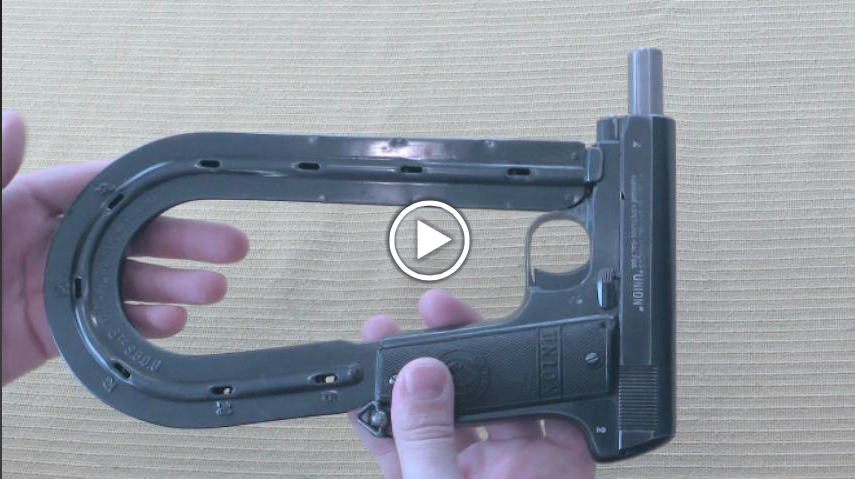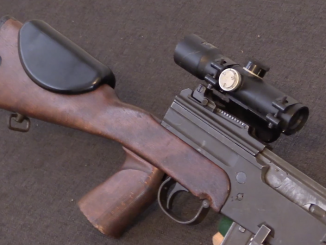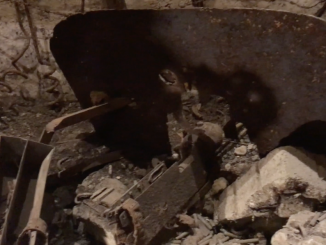Preorders now open for my book, Chassepot to FAMAS: French Military Rifles 1866-2016! Get your copy here!
While the development of the MAS 49 had given France a very utilitarian rifle that could serve as both for both marksmen and grenadiers, it could still be made better. In large part, the change to the 49-56 pattern was motivated by the move to adopt NATO-compatible 22mm rifle grenades. With the new muzzle hardware, several other changes were made. A gas cutoff was added, to prevent wear and tear on the action from grenade use (something that was found to be a real problem on the MAS 49). The gas port was also moved farther down the barrel, and the handguard and barrel were both shortened to make the rifle a bit lighter and handier.
Production began in 1957, and about 175,000 of the rifles were made, seeing as France’s standard front-line infantry rifle until the adoption of the FAMAS in 1979.




Sacre bleu, Ian! You did it again and said Yards instead of Metres! The french invented the meter after all.
Background to history of Meter
https://en.wikipedia.org/wiki/History_of_the_metre
It is most amusing to me as medieval units such as mile, yard and foot not to mention ounces and pounds still exist. Ludicrous 🙂
“(…)Ludicrous(…)”
In such case I could only link http://country-balls.com/the-metric-system/
I am sure if these rifles had been made in 7.62mm they would be much more popular, though less “French”.
I am surprised that only 175,000 were made. Back in the 1960s the French had conscription and very large armed forces. I can only assume that supplies of MAS 49s and 36s eked out the 49/56s.
A fascinating video as ever about a rifle I am never likely to see.
For one they had more than a million MAS 36 bolt actions built and not every soldier gets issued a personal weapon. Also there were the various SMG and pistols issued instead of rifles. The biggest factor has been what has always constrained the french army: lack of budget. traditionally they have to make do with the low funds they have, hence 1886 Lebel rifles still in service in 1940 for example.
The French Wikipedia says that 275000 were produced.
Is that production number correct? Didn’t the French militery have more rifles? It was a conscript army of millions.
And will be again…
https://www.cnn.com/2018/06/28/europe/france-national-service-trnd/index.html
Does this mean shift in European political landscape? We shall see. In any case, there is a cardinal difference between hired military and soldier-citizen. From ‘internationalism’ to nationalism in 10 seconds 🙂
Under the current circumstances, with NATO’s existence being questioned by the White House itself for the first time, any restoration of universal service has to be seen for its military dimension over its good-citizenship dimension. The problem with nationalism is, what one nation does to enhance its military power is always copied by its neighbors, undermining the whole point of the post-1945 European project in which the democracies would each contribute what they were good at to produce an allied military; French manpower, German tanks, and the ultimate American deterrent. Zero chance of these allies turning on each other. If everyone goes back to million-man conscript armies with full-featured armor and airpower, they have the same freedom of action that led to 1914. If everyone buys their own nukes instead, then things are worse than 1914.
The MAS 49 was rebarreled in 7.62 NATO, incompetently by Century Arms when they imported a large surplus batch, and competently by MAS for the Gendarmerie. Unfortunately the good 7.62 MAS 49s stayed in France, although they may eventually show up in the US as parts kits for somebody competent like DSA to build up. At the moment US collectors are better off with guns in the original 7.5×54 since Prvi Partizan still makes it, and the guns run properly.
That’s what I read couple of years ago. C.A. apparently fu-ked up and destroyed otherwise perfect rifles. Luckily, Prvi(first) Partizan can help to those who own originals.
I wonder if you could recut tthe chamber for the swiss GP11 cartridge as the swiss did with their Reibel machineguns?
[OFF-TOPIC SO IGNORE IF YOU WISH]
Recently FN unveiled FN MK 48 Mod 2 6.5CM that is machine gun for 6,5 mm Creedmoor cartridge: https://www.thefirearmblog.com/blog/2019/05/20/fn-unveils-machine-gun-in-65-creedmoor/
Do you think it would be success? Would other new 6,5 mm machine guns appear?
This is surprising move (pending my vague information base) and may suggest future motion toward unified rifle/MG round. What I recall, from not long time ago, there was consideration over new 6.5 shot but in light weight configuration; they even had .264/6.5×47 USA plan going.
https://uklandpower.com/2018/10/31/the-us-army-special-operations-command-usasoc-6-5-mm-precision-intermediate-calibre/
Yet, what I understand is that any new MG would go up with caliber, likely into .338 NM. Does this mean that both concepts are being evaluated? The 6.5 CM is kind of sharp-shooter specialty, not exactly suitable for MG application.
But again, plans are being changed all the time.
The main reasons for 6.5 Creedmoor in the MK 48 are twofold.
First, it will give commonality of ammunition with the new DMR in that caliber.
Second, and this is probably more important, the MK 48 in 7.62 x 51 NATO is a disaster. Due to being a modified Minimi (or M249 in DoDSpeak) it’s far too lightweight a weapon for the stresses of the 7.62 NATO cartridge, resulting in excessive wear and malfunctions. It also is nearly uncontrollable in full-auto fire.
Incidentally, this also strongly indicates that the “next generation” infantry rifle, instead of being a 6.8mm, will very likely be a 6.5mm as well. Having all three of the primary squad-level weapons using the same bore spec, even if they use two different actual cartridge cases, is a definite plus in mass production.
As for the .338 caliber, it and the .408 Cheytac (10.36 x 77mm) will likely replace the .50 BMG in both the ultra-long-range heavy sniper role and, eventually, the heavy machine gun role as well. But neither of those is generally considered a squad-level weapon.
cheers
eon
“(…)reasons(…)”
But introducing new cartridge for general purpose would need acknowledgment of need ot new inter^2-mediate cartridge, that is being between intermediate 5,56×45 NATO and 7,62×51 NATO or total abandonment of the second.
Considering that
1. The 7.62 x 51mm is now mostly used by NATO as a GPMG round, and those GPMGs are getting a bit long in the tooth overall;
2. The 5.56 x 45mm NATO round is the one thing everybody in NATO agrees on, i.e. nobody likes it or the rifles and SAWs that use it; and
3. Both rounds are over half-a-century old (7.62 1954, 5.56 1958);
It might just be that everybody agrees that if they need new rifles and GPMGs anyway (and they do), they may as well develop and field a new “optimized” cartridge while they’re at it.
Which BTW is what the British 0.280in (7mm) Enfield was supposed to be in 1951. That is, until the United States insisted on a .30 cal. (7.62mm) caliber for the new rifle and GPMG. Just so they could use existing barrel tooling, not to mention retain most of the ballistic performance of the .30-06 round.
They were half right. In certain areas (like the Mideast) having an effective range of over 800 meters comes in very handy. But you don’t necessarily need a 7.62mm bullet to achieve that.
Conversely, a 5.56mm won’t do it no matter how much you fiddle with the bullet weights and profiles. The laws of physics, specifically aerodynamics, are not on your side in this case.
with the above in mind, and considering that most of our likely opponents in the near future will be in areas resembling Iraq more than they do either Vietnam or the Fulda Gap, taking a necessary replacement cycle of infantry weapons up to company level as an opportunity to perform a caliber/cartridge changeover that was probably overdue anyway, makes pretty good sense from all standpoints; logistics, tactics, and capabilities.
Who knows? This time, they might even get it right.
cheers
eon
“(…)Who knows? This time, they might even get it right.(…)”
If this will happen I would… appreciate ability to admit that Venezuelans were actually right back in 1952…
http://www.cartridgecollector.net/7-x-49-second-optimum-liviano
Another consideration – we are entering the era of the armed drone.
It’s like 1915 again, we’re not just using them for observation, they’re trying to shoot each other down.
Now no one has suggested that 5.56mm can do the job. 7.62mm means you’re limited to much larger killer drones.
So eventually something in-between is coming.
Please do your homework before repeating rumors. The mk 48 is perfectly able to withstand 7.62 as the Minimi was first developped in 7.62 before 5.56 altough only offered to market in 7.62 many years later.
Given a choice, would you have rather gone into Vietnam with the MAS-49/56, the M14, the AR-10, or a whole warehouse’s worth of stolen AKM’s with matching ammunition?
For that kind of jungle warfare, the AK all the way. It would keep working when the others wouldn’t. As for range, most engagements, like most rifle engagements in any war except in the Mideast, were at 100 meters or less. Long range simply isn’t an issue in jungle or forest environments. The 5.56 x 45mm M193 (55-grain) is a more destructive round at those ranges, but the 7.62 x 39mm weapon is more likely to actually work in those conditions.
In the grasslands of the Central Highlands, it would be a different story, but that’s where you let the SAW carry the weight, preferably an MG42/59 or equivalent. Better yet, an M2 .50 on an ACAV, assuming you can’t lay your hands on an M163;
https://en.wikipedia.org/wiki/M163_VADS
Up to 2,000 meters effective range (either way) beats any rifle-caliber weapon you can hump.
cheers
eon
AKM is also distinctively shorter than other options, which might have some significance in such environment.
The AKM is what you get when an infantry rifle is properly designed for use by mechanized troops. Meaning, short enough to get in and out of an APC with, without compromising performance, reliability, or tactical handling.
The same cannot be said for M4, SA80, etc.
cheers
eon
Was SOP to reload with stripper clips? Or did guys get multiple magazines? The latch on the mags makes me think of trouble (I was a USMC grunt back int the 90s).
How do you destroy an anvil? Give it to a platoon of grunts/4th graders.
Four magazines were issued with the rifle. So using chargers/stripper clips was very common, with the receiver serving as a “magazine loading tool” to replenish the magazines. The magazines are heavy, so it saves weight I suppose to not have to carry very many. Ten rounds is less than, say, the FAL or the G3, but then again one can get lower to the ground in prone.
The French army also acquired G3s and SIG-Manurhin 5.56mm rifles from time to time while waiting for the FAMAS 5.56mm to come online.